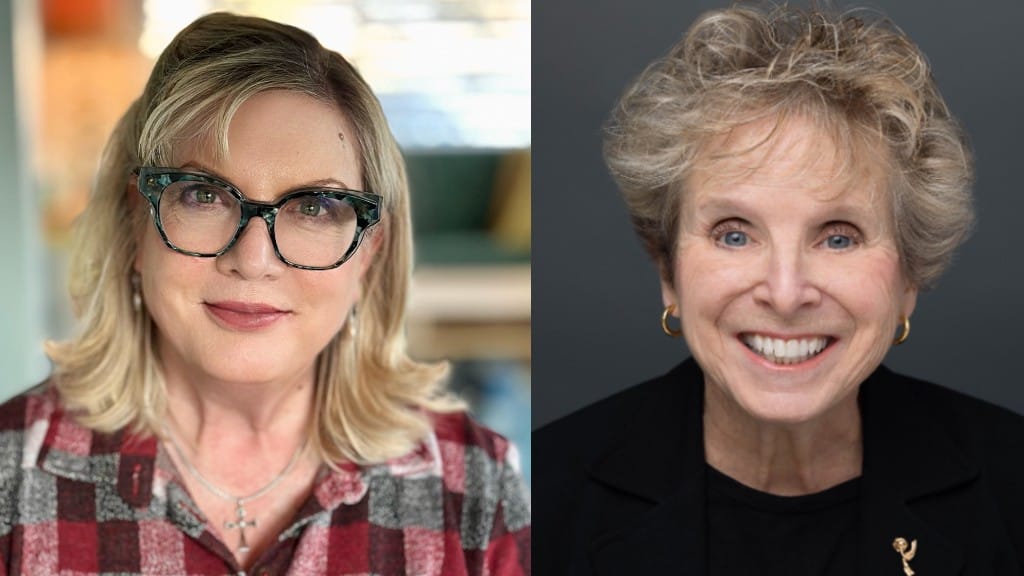Directors Bethany Rooney and Mary Lou Belli first teamed up 15 years ago to share their experiences in the moviemaking guide Directors Tell the Story: Master the Craft of Television and Film Directing. And while many things have stayed the same since then, plenty has changed — from streaming standards to the rise of intimacy coordinators to changes in the number of opportunities.
This month, they release the third edition of the book, which is packed with practical gems and updated advice on how to make it as a working director. The directors, whose credits include Elsbeth, Tracker, Criminal Minds: Evolution, The Ms. Pat Show, Chicago Med, and many more, shared some thoughts with MovieMaker about the book and their prolific careers.
We talked with them about starting out, letting the best idea win, and making room for new talent.

MovieMaker: One section of the book details how directors got their first jobs. Can you tell us about your first directing jobs?
Bethany Rooney: I started in the business as secretary to Bruce Paltrow and Mark Tinker on The White Shadow, then became the associate producer of St. Elsewhere, and then Bruce gave me my shot four years in. He believed in giving people their opportunity to direct — and I am forever grateful to him!
Mary Lou Belli: I was an acting coach on the series Charles in Charge and shadowed the director, Phil Ramuno, who was generous enough to let me into both of his shot listing sessions on the aforementioned show and the editing room on another. The EP, Al Burton, gave opportunities to three other desiring women on that same series.
MovieMaker: We have a regular feature called Things I’ve Learned as a MovieMaker. What would be one crucial thing you’ve learned making movies or television over the years?
Bethany Rooney: I believe it’s a three-part process before you even shoot. First you imagine your story. Then you prep it: block and shot list or storyboard it. Then you communicate it. You tell your production designer, your first assistant director, your director of photography, your whole crew, “This is how I see it, this is what I’d like to achieve.” You get them on board with your concepts, hopefully, they’re wildly enthusiastic, just as you are. Then you get to do the really fun part: shoot it. Now you’re getting the actors on board. Now you’re making a movie!
Mary Lou Belli: This is a people business. Your reputation depends on the impression you make and that is critical. It is important to be prepared so you are perceived as an artist who takes the craft seriously. Then it is vital to treat everyone with respect, knowing that they are your collaborators. And finally always give credit when someone has made a contribution.
MovieMaker: What is one problem you’ve solved on a project that you made you particularly proud?
Bethany Rooney: I keep having to learn this same lesson over and over. When I get behind in my schedule for the day, I need to take a look at what is left to shoot and figure out a way to accomplish it more quickly while still telling the story and maintaining the show’s style. The crazy thing is, those scenes are always my favorites! I think it’s because in that pressurized moment, my creativity becomes the driving force. I see the scenes differently, and allow myself to abandon standard coverage.
Mary Lou Belli: During Covid, I had an actor sent home because she had tested positive. The part this actor was playing was pivotal to the scene. She would die by the end of it. I had already shot the master but had yet to finish coverage that would include her close up while she was pummeled with bullets.
I had a suggestion from a camera operator who said that with a handheld camera, he could become the POV of that character watching her love interest, who was also dodging fire. That other character gave a magnificent performance — the camera operator “collapsed to the floor” while watching it.
This scene was based on a true life event of the death of Breonna Taylor.… It turned out to be so much better because this alternate way to tell the story humanized her death through the eyes of the man who loved her. I give credit to the camera operator for suggesting this, and I learned that the best idea wins.
Directors Tell the Story Authors Bethany Rooney and Mary Lou Belli on Changes in TV

MovieMaker: What recent trends do you see in film or television? Are they here to stay?
Bethany Rooney: Streamers have a different paradigm: They get all the scripts written before they begin shooting. This means that they can cross-board the shooting schedules, which further means that directors are hired usually for a block of two episodes. So now there are four directors for eight episodes. And four other directors are without those jobs. It’s part of the contraction of the industry – and I hope that trend doesn’t stay.
Mary Lou Belli: I see shorter orders and a general contraction in the industry. Where I was used to a TV season offering more opportunities for up-and-coming talented directors, there are just way less chances now. I hope this trend changes, I fear it might not. But it becomes more important for those lucky enough to be working to know that there will be less work, and if we want to ensure that up and coming talent gets a shot, we all have to be satisfied with less work.
MovieMaker: What makes the latest edition of your book special?
Bethany Rooney: Besides the fact that there’s a new chapter on Augmented Reality and Visual Effects, there’s a lot of updates on other areas of television production that have evolved in the past few years, especially as it was affected by the pandemic. Apps for directors, casting, intimacy coordinators, post-production, Zoom… We walk the reader through these new methods.
Mary Lou Belli: All our new and updated info is presented with the spirit in which the 1st and 2nd edition were written: with an eye toward giving inside information through practical application. We don’t hold back about the knowledge we have acquired while we’ve been in the trenches or in some cases prepping to get in the trenches.
For example, a director must study the show they are about to direct or would like to direct. By that keen observation, one figures out the style, tone and look of the show. We take the reader through that process and many more by sharing how we do it or things we have observed.
MovieMaker: Why should every director have your book?
Bethany Rooney: We have learned a lot by directing hundreds of episodes. We’ve also learned a lot by teaching the craft. It’s all practical, detailed, and road-tested. Both of us truly love directing television, and it shows on every page.
Mary Lou Belli: It’s a handbook. It is reference tool. And hopefully it is path toward a dream.
MovieMaker: What are you working on now?
Bethany Rooney: An episode of Criminal Minds – season 19 (!) on Paramount Plus.
Mary Lou Bell: I am wrapping the fifth season of The Ms. Pat Show where I direct as well as executive produce. I am returning in the fall to direct on another season of Elsbeth.
Directors Tell the Story: Master the Craft of Television and Film Directing is available on pre-sale now. Get 20% off with code 25ESA1


